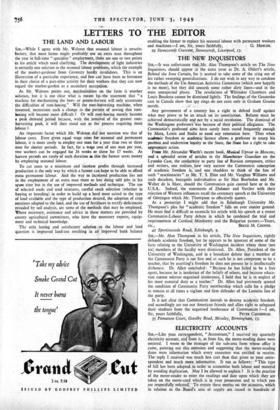LETTERS TO THE EDITOR
THE LAND AND LABOUR
S1R,—While I agree with Mr. Walston that seasonal labour is unsatis- factory, that most farms might profitably use an extra man throughout the year in full-time " specialist " employment, there are one or two points in his article which need clarifying. The development of light industries Is certainly one solution to the seasonal labour problems, which the example of the market-gardener from Coventry hardly invalidates. This is an Illustration of a particular experience, and few can have been so fortunate In their choice of a part-time activity for their workers that they can now regard the market-garden as a secondary occupation.
As Mr. Walston points out, mechanisation on the farm is another solution, but it is not clear what is meant by- the statement that "a machine for mechanising the beet- or potato-harvest will only accentuate the difficulties of root-hoeing." Will the root-harvesting machine, when invented, necessitate such a change in the pattern of sowing that root- hoeing will become more difficult ? Or will root-hoeing merely become a peak demand period because, with the removal of the greater root- harvesting peak, it will then stand out as the process requiring most labour ?
An important factor which Mr. Walston did not mention was that of labour costs. Even given equal wage rates for seasonal and permanent labour, it is more costly to employ one man for a year than two or three men for shorter periods. In fact, for a wage cost of one man per year, two workers can be engaged for 26 weeks or three for 17 weeks. As harvest periods are rarely of such duration as this the farmer saves money by employing seasonal labour.
To cut costs to a minimum and increase profits through increased production is the only way by which a farmer can hope to be able to afford extra permanent labour. And the way to increased production lies not in the employment of an extra man more or less doing odd jobs in his spase time but in the use of improved methods and technique. The use of selected seeds and seed mixtures, careful stock selection (whether in buying or breeding) in order to build up a herd most suited to the type of land available and the type of production desired, the adoption of crop rotations adapted to the land, and the use of fertilisers to rectify deficiencies revealed by soil analysis, are some of the methods that may be employed. 'Where necessary, assistance and advice in these matters are provided by county agricultural committees, who have the necessary experts, equip- ment and technical knowledge.
The only lasting and satisfactory solution to the labour and land question is improved land-use resulting in an improved bank balance enabling the farmer to replace his seasonal labour with permanent workers and machines.—I am, Sir, yours faithfully, G. MERCER. 29 Stoneycroft Crescent, Stoneycroft, Liverpool, 13.


































 Previous page
Previous page